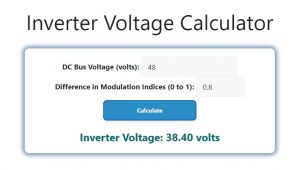About Inverter Voltage Calculator (Formula)
An Inverter Voltage Calculator is an essential tool for engineers and technicians working with inverter systems in various applications, including renewable energy, electric vehicles, and industrial machinery. This calculator helps determine the output voltage of an inverter based on the DC bus voltage and modulation indices, which are critical for optimizing the performance and efficiency of inverter systems. Understanding how to calculate inverter voltage is crucial for designing and troubleshooting these systems effectively.
Formula
The formula to calculate inverter voltage is as follows:
Inverter Voltage (VI) = DC Bus Voltage (Vdc) * Difference in Modulation Indices (dm)
Where:
- DC Bus Voltage (Vdc) is the voltage level provided to the inverter from the DC source, such as batteries or solar panels.
- Difference in Modulation Indices (dm) refers to the difference in modulation levels applied to the inverter’s output.
How to Use
- Gather Data: Determine the DC bus voltage from the power source and the modulation indices for the inverter.
- Apply the Formula: Multiply the DC bus voltage by the difference in modulation indices to calculate the inverter voltage.
- Analyze Results: Use the calculated inverter voltage to assess the performance and compatibility of the inverter with the connected load.
Example
Suppose you have a DC bus voltage of 48 volts and the difference in modulation indices is 0.8. To calculate the inverter voltage:
Inverter Voltage (VI) = 48 V * 0.8
Inverter Voltage (VI) = 38.4 V
This means that the output voltage of the inverter will be 38.4 volts.

FAQs
- What is an inverter voltage calculator?
An inverter voltage calculator is a tool used to determine the output voltage of an inverter based on the DC bus voltage and modulation indices. - Why is inverter voltage important?
Inverter voltage is crucial for ensuring that the inverter can effectively power the connected load without overloading or damaging the system. - What is DC bus voltage?
DC bus voltage is the voltage supplied to the inverter from a direct current source, such as batteries or solar panels. - What are modulation indices?
Modulation indices are values that indicate the level of modulation applied to the inverter output, affecting the quality and efficiency of the inverter’s output voltage. - How do I determine the modulation indices?
Modulation indices can be determined through the design specifications of the inverter or measured directly from the inverter control system. - Can I use the calculator for different inverter types?
Yes, the inverter voltage calculator can be used for various types of inverters, including those used in renewable energy systems, electric vehicles, and industrial applications. - What units are used for DC bus voltage?
DC bus voltage is typically measured in volts (V). - What happens if the inverter voltage is too low?
If the inverter voltage is too low, the connected load may not operate properly, leading to inefficiency or malfunction. - What happens if the inverter voltage is too high?
If the inverter voltage is too high, it may damage the connected load or the inverter itself, potentially causing system failure. - How can I improve the inverter voltage output?
Improving inverter voltage output may involve optimizing the DC bus voltage, adjusting modulation indices, or using a higher quality inverter. - Is there a specific range for modulation indices?
Yes, modulation indices typically range from 0 to 1, where 1 represents maximum modulation. - How does temperature affect inverter voltage?
Temperature can impact the efficiency and performance of the inverter, which may indirectly affect the output voltage. - What are the common applications of inverter voltage?
Common applications include solar energy systems, electric vehicles, and variable frequency drives in industrial motors. - Can I calculate inverter voltage manually?
Yes, you can calculate inverter voltage manually using the provided formula if you have the necessary data. - What tools are available for measuring DC bus voltage?
Common tools for measuring DC bus voltage include multimeters and oscilloscopes. - What is the difference between AC and DC voltage?
AC (alternating current) voltage periodically reverses direction, while DC (direct current) voltage flows in one direction only. - How often should I check inverter voltage?
It is advisable to check inverter voltage regularly, especially during system maintenance or after significant changes to the electrical system. - Can inverter voltage affect energy efficiency?
Yes, proper inverter voltage ensures efficient energy transfer, while incorrect voltage can lead to energy losses. - What safety measures should I take when working with inverters?
Always follow safety protocols, including disconnecting power sources, using insulated tools, and wearing appropriate protective gear. - Where can I find more information on inverter systems?
More information can be found in electrical engineering textbooks, manufacturer documentation, and online resources focused on inverter technology.
Conclusion
An Inverter Voltage Calculator is a valuable tool for understanding and optimizing the performance of inverter systems. By applying the formula to calculate inverter voltage based on DC bus voltage and modulation indices, users can ensure their inverters operate effectively and safely. Understanding this concept is essential for anyone working with inverters, whether in renewable energy, electric vehicles, or industrial applications, ultimately contributing to improved energy efficiency and system reliability.